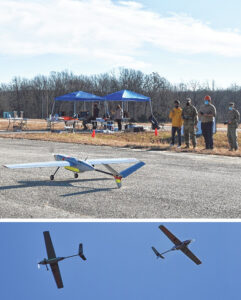Axient Corporate Overview
Discover our breakthrough solutions for mission success.
Learn More
 Fort Leonard Wood, MO (December 14, 2020) –
Fort Leonard Wood, MO (December 14, 2020) –
Soldiers from Fort Carson, Colorado, and Fort Rucker, Alabama, along with experts from Millennium Engineering & Integration, converged on Fort Leonard Wood last week to demonstrate and assess Millennium’s unmanned autonomous aircraft flight safety software called Autonomous Intelligent Flight Management System, or AIFMS.
The event — held at Training Area 219 — provided an opportunity for Army unmanned aerial systems experts to get hands-on experience with Millennium’s prototype technology while also giving Millennium developers the chance to gain valuable feedback from Soldiers who may someday use the system, said Kyle Henry, the Maneuver Support Battle Lab’s Experimentation Branch chief and one of the key organizers of the technology assessment.
“It’s mutually beneficial for both parties,” he said. “Our primary function (at the Battle Lab) is to support capability development for Army modernization. We’re looking at prototype-level technologies in an operationally relevant environment in the hands of Soldiers … to help shape both the capability and its development. On the technology provider side — AIFMS, for example, is coming from private industry — we get to show them what we’re looking at in terms of what the Army needs.”
One of the scientists from Millennium — Dr. Lina Castano, who leads the AIFMS project at Millennium in Arlington, Virginia — said the software gives unmanned aircraft a major safety upgrade while also mitigating potential faults.
“It’s a collision avoidance system,” she said. “But also, if an aileron gets jammed, for instance, or if an engine loses power, the software will guide the aircraft to safety.”
Castano added that the software is completely stand alone and communicates with the autopilot of the aircraft. It uses GPS signals along with the transceivers from neighboring aircraft to ensure a safe flight.
For the assessment, the Millennium team launched three unmanned aircraft.
“The main aircraft — what we’re calling the AIFMS aircraft, because it has all of our safety software on board — was on an autonomous mission and we basically tried to intercept it with the other two aircraft,” Castano said. “We had transceivers on the two intercept aircraft and the onboard computer in the AIFMS aircraft picked up those signals. It veered away to avoid a collision multiple times from different angles.”
The other half of the assessment called for a fault to be detected and corrected for — the software enabled the aircraft to continue its mission with a stuck rudder, Castano said.
One of the Soldiers who helped with the assessment was Sgt. Charles Congleton, an infantryman assigned to Company A, 4th Battalion, 9th Infantry Regiment at Fort Carson — one of his duties is the operation of RQ-11 Raven unmanned aerial vehicles, which provide maneuver reconnaissance and surveillance. He said the software seems like an upgrade because it communicates with other aircraft and provides another level of safety when a UAS is flying beyond the line of sight.
“When we have our UASs up in the air, a lot of fixed wing and rotary wing pilots are a little afraid to fly because they don’t know that our birds are in the air unless we call it up,” he said. “With this, it’s letting them know; it talks to and looks out for the other aircraft.”
Chief Warrant Officer 4 James Tumey, the senior UAS operations officer at the U.S. Army Aviation Center of Excellence at Fort Rucker, was also on hand and said he was able to get all the data he needs to complete his assessment.
“It went well,” he said. “It was able to complete the mission and come back without command and control of the aircraft.”
The assessment of the AIFMS software was this year’s final event of the annual Maneuver Support, Sustainment and Protection Integration Experiments, or MSSPIX, which provides capability developers with credible and validated operational experiment venues for their conceptual and materiel development, Henry said.
“Without the Soldiers, this would be a glorified tech demo,” he added. “That’s not what we’re trying to do. We want a non-biased look at these technologies, these capabilities.”
Castano said the software has been in development for three years with assistance from graduate and post-graduate engineering students at the University of Maryland at College Park.
“It’s been a long development process,” she said. “It’s a very large piece of software with a lot of parts that all had to be integrated. This has been a team effort, and everybody has put their best foot forward. We’re very happy to have the Soldiers also do an excellent job. They’ve picked up our software very well. So, it’s been a very successful time at Fort Leonard Wood.”
Original article found here.
Photo and article courtesy of Brian Hill.